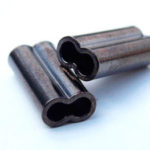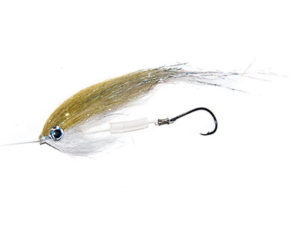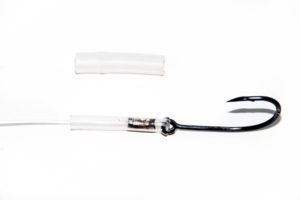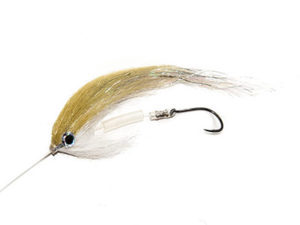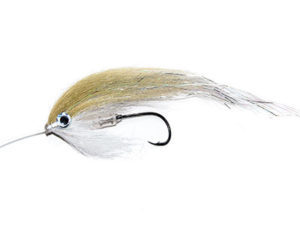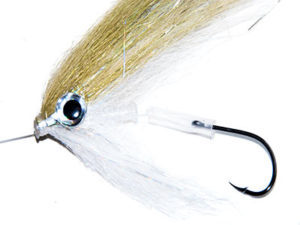How To Rig Hooks With Tapam Special Tube Flies
The “Tapam Special” is a large baitfish pattern that I developed for the big tarpon at Tapam Lodge in Nicaragua. One of the reasons for using a tube fly is better hook holds. When tarpon jump and shake their head the big flies add leverage to the light hook holds and this can force the hooks to dislodge. With tube flies the fly will separate from the hook, thus reducing the forces on the hook. The challenge with this type of fly is that the hooks that are used are very big. My standard hook is a 6/0 TMC600SP. This hook has a very large eye to accommodate large diameter tippets (I use 130lbs fluoro carbon). In order to accommodate this size of hook we had to manufacture a larger size tube and a larger size junction tubing.
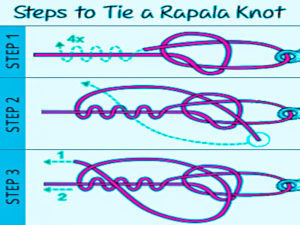 When fishing with smaller eyed hooks there may be an issue that the hook does not sit snug in the junction tubing that comes with the fly. There are a couple of ways to get around this. I am going to go over some rigging options here.
When fishing with smaller eyed hooks there may be an issue that the hook does not sit snug in the junction tubing that comes with the fly. There are a couple of ways to get around this. I am going to go over some rigging options here.
First of all there are basically three ways to attach the hook to the leader; a form of clinch knot, a form of loop knot and a crimped loop. I don’t use any clinching knots because it reduces the mobility of the hook. I feel that a mobile hook on a loop has a better chance of finding a hook hold. A hook on a loop also rides better in the water, thus helping fly tracking. For me that leaves the two loop options. With leaders under 100 pounds I use mostly a Rapala loop knot (non-slip mono loop knot).
For leaders 100 pounds and up I use a crimp. I prefer the crimp for two reasons; less bulky and always keeps the loop in line with the leader. Once you get used to using crimps they are very fast. I like using double barrel brass crimps. I prefer them over aluminum once which are bulkier.
The breaking strength variation between any of these methods does not matter to me. All are plenty strong. 90% of the fish are lost on poor hook hold, and the ones that are lost through leader failure are mostly due to abrasion of the leader. The leader to hook connection rarely fails. The ones that I see fail are due to knots that are tightened poorly and slip.
Let’s Have a Look at Some Rigging Variations:
Image 2: An eight inch long Tapam Special tube fly rigged with standard 4.5mm junction tubing and a #4 TMC600SP hook.
With this setup the junction tube will slide snug onto the tube of the fly, and the eye of the TMC600SP will sit snug into the tubing. I personally fish this setup the most. I find that the hook separates from the fly well, but sits tight enough in the tubing to keep the fly in point-down-position and help with tracking of the fly. After sliding the junction tubing on the tube and the hook into the junction tubing the rig will look like this:
Image 3: Here we see the same TMC600 hook (#4), rigged on 60lbs mono with a brass double barrel crimp. I have rigged it here with a 4.0mm junction tubing (above it is the 4.5mm junction tubing). As you can see this junction tubing does not quite fit over the large eye of the TMC600SP. For smaller eyed hooks this size tubing will work well.
Some hooks, like some Gamakatsu or Owner models, have eyes that are smaller than the 600SPs. In those cases the eye may not fit snug into the 4.5mm junction tubing. There are a number of ways that we can work around that;
Image 4: The same fly rigged with a free-swinging hook; 60lbs mono, double barrel crimp, 4mm junction tubing and a small eyed Owner SSW #3/0.
For smaller eyed hooks 4mm junction tubing can be used. Slide it over the crimp and hook eye so that the junction tubing extends just past the crimp towards the fly. This will help to keep the hook tracking in line with the tube. The hook will swing free.
Image 5: Rigging for a connected small eyed hook. The 4mm junction tubing that is placed over the crimp and hook eye will fit snug inside the 4.5mm junction tubing that is attached to the fly.
If you prefer to attach smaller eyed hooks to the fly then the following can be done; leave the 4.5mm junction tubing that comes with the fly on the fly. Proceed to rig up the hook like you would for the free-swinging rig described in image 4. Now simply slide the hook and 4mm junction tubing into the 4.5mm junction tubing. The 4mm junction tubing will fit perfectly inside the 4.5mm junction tubing, thus fixating it to the fly. The rigging is shown in the image below.
Image 7: A small-eyed Owner SSW #3/0 hook, tied on with a Rapala loop knot. Covered with a piece of 4mm junction tubing; a free-swinging hook rigging.
For those who like to attach their hooks the old fashioned way, with a knot, there are some similar options. Firstly a piece of 4mm junction tubing can be used to but the free swinging hook against the tube:
Image 8: Hooks with small eyes that are tied on with a knot can be pulled directly into the plastic tube.
Another good way to fish a small eyed hook that is attached with a Rapala knot is to pull the hook directly into the tube. Just remove the junction tubing and most smaller eyed hooks will fit directly into the plastic predator tube that the Tapam Special is tied on.

